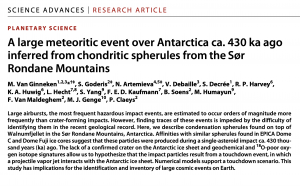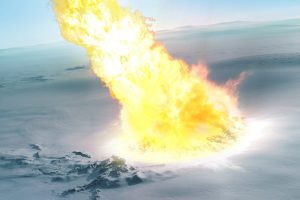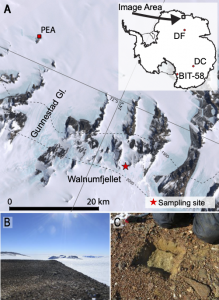
Remnants of hypervelocity impacts on the surface of the Earth are mainly preserved as impact craters. However, large airbursts occur an order of magnitude more frequently than crater forming impacts; finding traces of such airbursts in the geological record is impeded by the difficulty in identifying them.
This paper reports the discovery of extra-terrestrial particles resulting from a large airburst on the flat glacially eroded top of nunatak Walnumfjellet in the Sør Rondane Mountains, Queen Maud Land, Antarctica. Furthermore, their unusual isotopic signatures suggest interaction with Antarctic ice during their formation in a dense and hot plume resulting from a touchdown impact, intermediate between an airburst and a crater-forming impact.

The main science highlights are:
- The discovery of unusual impact particles of chondritic composition on top of an old glacially eroded nunatak in the Sør Rondane Mountains, Antarctica.
- The impact particles are depleted in 18O with respect to bulk chondritic values, suggesting that they interacted with 18O-poor Antarctic ice upon condensation in a hot and dense impact plume.
- The unusual morphology, textures and oxygen isotopic signatures suggest that they are paired with ca. 430 ka old impact particles forming a discrete layer in the EPICA Dome C and Dome Fuji ice cores; this impact is one of two large meteoritic impacts over Antarctica over the last 800 ka recorded in these ice cores.
- Numerical models support a touchdown scenario, intermediate between an airburst and a crater-forming impact, during which the high-velocity vapor jet produced by the total disruption of an asteroid reached the Antarctic ice sheet.
- This study will serve as a guide to identify such unusual impacts in the geological records and help reassess the threat posed by medium-sized asteroids.

Mocked up illustration of touchdown impact on Antarctica by Mark A. Garlick

Figure 1 of the paper, mainly good to show the sampling site and its geographical location in Antarctica: Location of the sampling site in WN, Sør Rondane Mountains, Queen Maud Land, Antarctica. (A) Landsat image of the sampling site on the summit of WN, where the particles studied here were recovered, along with the Princess Elisabeth Antarctica (PEA). Inset shows the locations of Dome Fuji (DF), Dome Concordia (DC), and BIT-58 for comparison (8, 9, 24). The ages of the various horizons can be found in Table 1. (B) The flat glacially eroded summit of WN on the border of the Antarctic plateau. 10Be exposure age of glacially eroded surfaces of WN range from 870 to 1740 ka (25). (C) The 30 × 30 × 10 cm sampling site on top of WN. Landsat 7 image courtesy of the Landsat Image Mosaic of Antarctica (LIMA) project. Photo credit: Matthias van Ginneken, University of Kent.